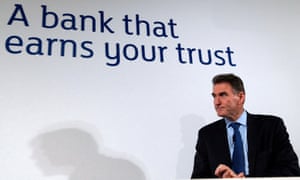RBS’s past sins are still shaping the bank’s future

ight years after the banking crisis, Royal Bank of Scotland (RBS) has failedits annual health check. If this were a medical before getting life insurance, it would be like a doctor telling the patient to get fit; it is not notice of sudden death.
So the bailed-out bank – already being kept alive by a £45bn lifeline from the taxpayer – is taking another dose of medicine to try to get itself into better shape. The prescription involves pulling back from riskier activities, and cutting costs. Next year it could get more difficult when the chief executive, Ross McEwan, is expected to embark on a fresh round of cost-cutting. That may well mean more jobs are on the line.
The failure, though, is important. It illustrates the battle McEwan faces in getting the bank into a good enough shape so that the government stands a chance of selling off the 73% stake it still owns in the Edinburgh-based bank. As the Bank of England put it: “RBS remains susceptible to financial and economic stress.”
Why? The lending spree it embarked on before the 2008 crisis has left the bank with customers who find it difficult to make repayments when times get tough. Some 60% of its loans in Ireland are at risk of not being repaid. The bailout in 2008 was regarded by Brussels as state aid and one of the conditions attached was that RBS sell off a 300-branch network. That is proving troublesome (and any hope of a profit on the sale seems to be long gone). Low interest rates are making it harder to generate profits that can be used to help bolster its financial position.
Crucially, it is still confessing its sins from the past. A key reason its health check went badly is that the Bank of England asked it to fess up about how much it might face in fines and legal costs in the year ahead. The figure has not been made public but analysts have calculated that the US Department of Justice could demand up to £8bn to rectify a decades-old mis-selling scandal. The Bank of England said it had included “stressed projections of misconduct costs”.
In one way, though, the results of the so-called stress tests can be used to demonstrate that this is not the RBS of the past. The hypothetical scenario that the Bank of England subjected the main lenders to was the toughest yet – and not too dissimilar to the backdrop of the 2008 crisis. The test included a contraction in the global economy of almost 2%, a plunge in oil prices and nose-diving UK house prices.
In 2008 a key measure of its financial strength – its capital ratio – stood at 4%. RBS went into this assessment with a 15% capital ratio – the highest of any of the seven lenders tested, apart from Nationwide.
Even so, there is little to cheer for taxpayers. Philip Hammond, the chancellor, has already admitted he has abandoned any immediate hope of selling any more of the stake. The Office for Budget Responsibility is no longer factoring in any sales during the lifetime of this parliament. In March it had expected £21.5bn of sales of RBS shares – although given the stake is currently worth around £16bn, this projection would have been revised down.
For savers, the picture is the same as before: £75,000 of savings is guaranteed – as it is for all UK banks – by the financial services compensation scheme.
With the sell-off heading further into the distance, the questions about whether a new prescription is needed may start to get louder. The New Economics Foundation, for instance, thinks a better medicine would be the more radical option of turning it into a network of local banks. Ideas in the past have included carving out a bad bank or giving away the shares to the public. RBS will be hoping that its own medicine will be enough to get it fit for next year’s assessment.
[Source:- Gurdian]

